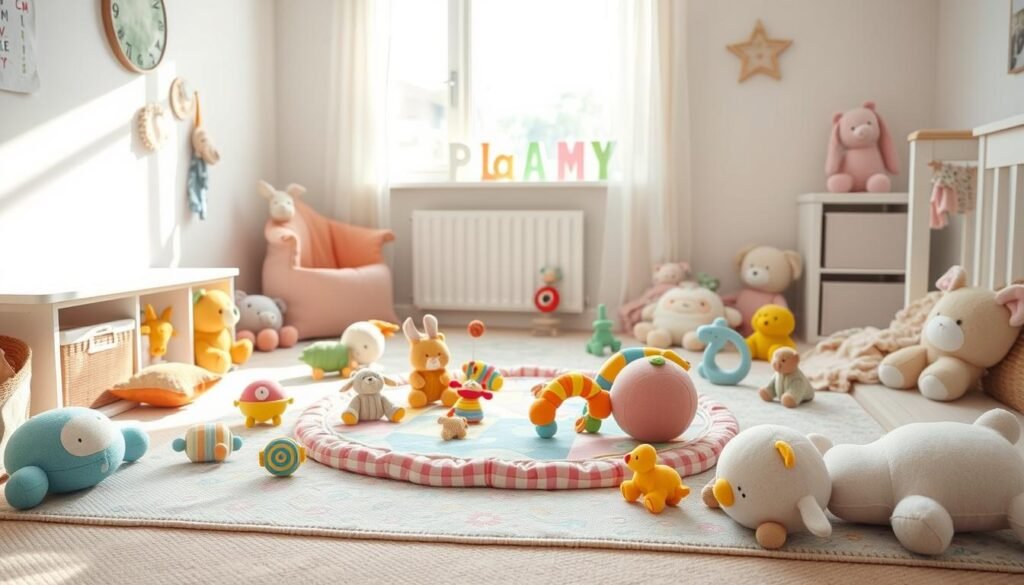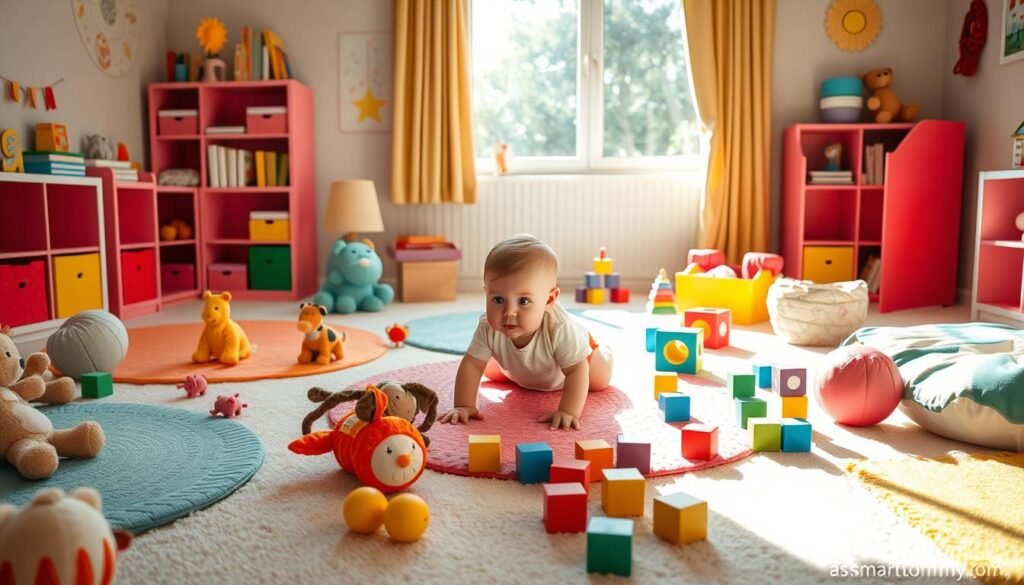As parents, we can’t wait for our babies to start crawling. It’s a big step in their growth. Crawling needs coordination, muscle strength, and balance. Most babies start crawling between 7 and 10 months1.
In 2022, the CDC stopped tracking crawling as a milestone. They said there wasn’t enough proof of when 75% of babies crawl1. But the AAP still says babies should do 30 minutes of tummy time a day. This helps build the muscles for crawling1.
Every baby is different, and some might not crawl at all. Others might start later1. But helping your baby crawl is a great experience. Here are 8 tips to help your baby move and explore.
Understanding Baby’s Crawling Development Milestone
Crawling is a big step in a baby’s growth. It shows they are getting better at moving around2. Most babies start crawling between 6 and 10 months old. By 8 months, about half of them can crawl3.
This crawling helps babies learn to move, balance, and understand space. It’s a key step towards being more independent and mobile.
Normal Crawling Age Range
Babies usually start crawling between 7 and 10 months. But, every baby grows at their own pace4. Premature babies might need more time to crawl4.
The CDC says crawling is not a must for all babies. Some might go straight to walking without crawling4.
How Crawling Affects Development
Crawling is a complex skill that needs many abilities. It helps babies learn to navigate, remember things, and understand their world3. Even if they don’t crawl the usual way, they can still grow and learn3.
CDC Guidelines and Research
The CDC doesn’t list crawling as a key milestone anymore. This is because not all babies crawl by a certain age4. But, crawling might help babies walk faster than other ways of moving4.
Doing activities that strengthen muscles, like tummy time, can help babies crawl better4.
In short, babies usually crawl between 6 and 10 months, with half crawling by 8 months2. But, every baby is different in how and when they crawl3. Playing, keeping a safe space, and encouraging tummy time can help a baby crawl and grow4.
Signs Your Baby is Ready to Start Crawling
As your baby grows, you might see signs they’re getting ready to crawl. Babies usually start showing signs of crawling around 8 months old5. But, some start as early as 6 months, while others may not start until after 11 months5. It’s important to remember that not crawling on time doesn’t always mean there’s a problem5.
One early sign is when babies scoot backward on their bellies, known as the “army crawl” or “inchworm crawl.”5 They might also push up during tummy time, which helps build muscle and coordination6. As they get better, they might start scooting forward on their bellies, usually between 8 and 9.5 months5. Then, they might get into a hands-and-knees position and rock back and forth, showing they’re ready to crawl6.
Research shows babies crawl slower on hard floors like wood compared to soft surfaces5. They might try different ways of crawling, like belly-crawling or hands-and-knees crawling5. Leaner babies tend to start crawling sooner because they have more muscle compared to their body fat5.
By watching for these signs and encouraging your baby’s curiosity, you can help them reach this important milestone6. Remember, every baby is different, and some might skip crawling and start walking instead6.
Being aware of your baby’s development and creating a safe, engaging space can help them crawl better7. By knowing the signs of crawling readiness, you can celebrate your baby’s progress and support them as they start this new chapter7.
When Do Babies Start Crawling
The journey of infant mobility is an exciting milestone in a baby’s development. Babies usually start crawling around 9 months or later. But, the crawling age range can vary a lot8. Some start as early as 6 or 7 months, while others may not start until after 10 months8.
It’s also important to note that not all babies crawl. Some may go straight to standing and walking8.
Typical Progression Timeline
Many babies start learning to crawl around 7 months9. Most are fully crawling by 9 months9. By one year old, they should be crawling well and exploring9.
Around 6 or 7 months, babies start moving a bit on their tummy. This is in preparation for crawling9. By 9 months, they should be able to sit unaided and support themselves on all fours9.
Individual Variations in Development
Every baby develops at their own pace. Some may start crawling as early as 6 or 7 months10. Others may not crawl until after 10 months or even skip crawling altogether8.
Crawling speeds also vary. Some babies are very fast, while others move only a few inches8.
Factors Affecting Crawling Onset
Several factors can influence when a baby starts crawling. These include physical development, body weight, premature birth, and personal preferences8. Some babies may focus on other skills before crawling8.
Pediatricians do not consider any crawling style superior to others9. Late crawling may only be a concern if it occurs alongside other signs of developmental delay9.

The crawling journey is unique to each child. It’s essential to observe your baby’s development and provide a safe environment for them to explore. With patience and encouragement, your little one will find their way to crawling and beyond, at their own pace8109.
The Essential Role of Tummy Time in Crawling Development
Tummy time is key for your baby’s motor skills and crawling11. Newborns or young babies often round their back during tummy time. By 5 months, they should lift their head to a 45-degree angle11. As they get older, they may start belly crawling and move from belly to sitting11.
Playing with toys during tummy time helps develop muscles in their head, neck, and upper body1112. Babies can start Tummy Time as newborns. Around 7-9 months, they usually start crawling12. The American Academy of Pediatrics suggests at least an hour of Tummy Time per day by 3 months12.
Start with short Tummy Time sessions and increase as your baby gets stronger12. After crawling starts, Tummy Time is still good but not as critical12. By focusing on this activity, you help your baby’s motor skills and support their crawling milestone.
| Tummy Time Recommendations | Newborns | 3 Months | 5 Months | 7-9 Months |
|---|---|---|---|---|
| Head Lifting Angle | Slight Back Rounding | 45 Degrees | 45 Degrees | Crawling Begins |
| Daily Duration | Few Minutes | 1 Hour | 1 Hour | Beneficial, Not Essential |
Common Crawling Styles and Variations
Babies show a wide range of crawling styles as they start moving. The classic hands-and-knees crawl is common, but many try other ways too. These different methods are interesting to watch13.
Classic Hands-and-Knees Crawl
The classic crawl is when babies move their arms and legs in sync. This helps them get stronger and better at moving around14.
Alternative Crawling Methods
Babies might also try crawling in other ways. Some do a belly crawl, moving their arms and dragging their belly. Others might do a bear crawl, using hands and feet like a bear. The crab crawl is different, pushing with arms to move sideways or backward13.
Unique Movement Patterns
Not every baby crawls the usual way. Some are great at rolling to get around. Others might leapfrog, using their arms and legs to jump forward. These special ways of moving are important for their growth13.
Every crawling style helps babies move and explore. They learn important skills like balance and coordination14.

| Crawling Style | Description |
|---|---|
| Classic Hands-and-Knees Crawl | Alternating movement of arms and legs to propel forward |
| Belly/Commando Crawl | Using arms to pull and dragging belly along the floor |
| Bear Crawl | Using hands and feet to mimic a bear’s movement |
| Crab Crawl | Pushing with arms instead of pulling, often leading to backward or sideways movement |
| Leapfrog Crawl | Making a bridge with arms and legs before thrusting forward |
| Rolling | Using rolling as the primary form of movement |
“There are 25 unique combinations of body parts observed in crawling babies.”13
Babies show amazing diversity in how they crawl. Whether it’s the classic crawl or something unique, each baby’s journey is special. It shows the incredible ways babies adapt and grow1314.
Practical Tips to Encourage Your Baby’s Crawling Journey
Watching your baby’s first crawling attempts is exciting. As parents, we can help them learn this important skill. Here are some tips to support your baby’s crawling journey.
- Place favorite toys just out of reach. This will motivate your baby to stretch, rock, and crawl to retrieve the toys15.
- Provide supportive positioning under your baby’s chest during tummy time. This helps build the necessary muscle strength for crawling15.
- Demonstrate crawling movements yourself, encouraging your baby to imitate you. This visual cue can inspire them to start moving16.
- Use music or songs to encourage rocking on hands and knees, a precursor to crawling. The rhythmic movements can help trigger the crawling reflex16.
- Avoid slippery clothing on hard surfaces, as this can hinder your baby’s attempts to crawl. Opt for non-slip socks or bare feet for better traction16.
It’s key to create a safe and interesting environment for your baby to explore and practice their crawling skills. Avoid using baby walkers, seats, or carriers too much. These can limit the crucial floor time needed for crawling development1516.
Remember, every baby develops at their own pace. Try not to push your little one before they’re ready. Patience and encouragement will support their crawling journey15.
“Crawling is a crucial milestone that helps babies develop strength, coordination, and problem-solving skills. By creating a safe and engaging environment, we can nurture this important stage of their growth.”

| Crawling Preparation Activities | Benefits for Baby Development |
|---|---|
| Tummy Time | Strengthens neck, shoulder, and arm muscles needed for crawling1516 |
| Reaching for Toys | Encourages movement and exploration, leading to crawling1516 |
| Rocking on Hands and Knees | Develops the coordination and muscle control for crawling16 |
By following these practical tips and creating a supportive environment, you can help your baby’s natural crawling development. This supports their overall growth and well-being1516.
Creating a Safe Environment for Crawling Practice
As your baby starts crawling, it’s key to make your home safe. Secure electrical outlets and put up baby gates on stairs. Also, use toilet seat locks and anchor furniture to walls. Crawling safety is very important as your baby moves around17.
Babyproofing Essentials
Make a “yes” space for your baby with toys and books. Remove small objects that could be choking hazards. Check the area often for new dangers as your baby gets more mobile18.
Setting up Crawling Spaces
Give your baby a soft floor to crawl on. Use mats or rugs to cushion falls. Make sure the area is free from sharp edges or corners18.
Safety Considerations
Always watch your baby while they crawl. 90% of crawling accidents happen when parents look away17. Use safety gates at stairs to lower fall risks by 80%17. Think about using crawling knee pads for comfort and to prevent bruises17.
By making a safe and fun space, your baby can explore safely. Remember, baby-proofing and crawling safety are key for your baby’s infant mobility during this important time171819.,,
Pre-Crawling Exercises and Activities
As your baby’s motor skills grow, doing pre-crawling exercises and activities can help them start crawling20. Babies usually start crawling between 7 months and 10 months20. Some might even skip crawling altogether20. You can encourage crawling by placing toys just out of reach, setting up obstacle courses, and watching them play20.
To build muscle and coordination for crawling, try these activities:
- Encourage pushing up on hands during tummy time
- Motivate reaching for toys while on the belly
- Play in an all-fours position over your legs
- Practice sidesitting for core strength
- Attempt supported kneeling positions (low and tall kneels)
Using toys and mirrors can also motivate your baby’s movement20. Signs of readiness to crawl include constant movement, arching the neck, grabbing feet, rolling over, and rocking on hands and knees20.
| Pre-Crawling Activity | Benefits |
|---|---|
| Tummy Time | Builds arm strength for crawling21 |
| Supported Kneeling | Develops core stability and coordination21 |
| Reaching for Toys | Enhances motor planning and hand-eye coordination22 |
These exercises and activities help your baby get ready for crawling22. Remember, every baby develops at their own pace. Be patient and celebrate each small step21.
When to Seek Professional Guidance
As a parent, knowing when to worry about baby development milestones is key. Most babies start crawling between 7 and 12 months old. Some might start as early as 6 months, while others might take up to 12 months23.
If your baby only crawls on one side, shows no progress, or doesn’t try to move by 12 months, it’s time to see a doctor23.
Not every baby crawls, and that’s okay. But if your baby doesn’t want to explore or move, it might be a sign of a problem24. In the U.S., you can get free early intervention evaluations without a doctor’s note. These experts can check your baby’s development and offer help if needed24.
Every baby grows at their own pace. But if you’re worried about your child’s progress, don’t wait. A healthcare provider can offer the support your baby needs. With their help, your baby can grow and explore the world around them.


